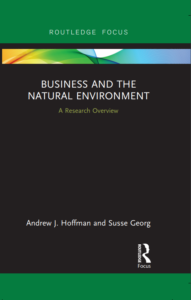How have business scholars sought to understand the interactions between business and the natural environment, and where might the field be heading next? This concise volume by two leading scholars provides answers to these questions.
The framework is the cumulation of their central experiences in the debates as well as their prior work in developing an integrative perspective on the field. The volume serves to welcome new scholars into the conversation and inspire debates with more established colleagues.
The larger part of the book reviews past developments. The authors provide a condensed yet authoritative overview by mapping the citation networks of key publications and interpreting the lines of research – both developed and left open. One takeaway here is that the field is weakly structured in the sense that most of the research is connected but the links often stretch across several steps that require going back to a pivotal wave of papers from the 1990s, especially a special issue of the Academy of Management Journal in 1995. This issue seems to have imprinted the field to map itself onto the existing shape of theoretical frameworks in management studies (e.g., institutional, resource-based, and stakeholder theories, etc.). In this way, the literature has a hybrid identity of both conforming to dominant research frameworks and belonging to an alternative community of environmental business scholars.
 One could easily argue that this has been a highly successful approach to growing the business & natural environment field (becoming internally “sustainable” as the authors point out), while achieving considerable impact among broader management scholars.
One could easily argue that this has been a highly successful approach to growing the business & natural environment field (becoming internally “sustainable” as the authors point out), while achieving considerable impact among broader management scholars.
However, set against the backdrop of accelerating environmental decline, it is unclear whether the field has delivered on its promise of enlightening the business-environment relationship.
The second part of the book addresses this troubling situation by issuing a provocative challenge to return to the critical roots of the field. Hoffman and Georg sketch out the revolution in our place in the world that is the Anthropocene, and some of its implications for redirecting scholarship. Here the details become less clear, reflecting the emergent and open-ended nature of the topic. Nevertheless, the authors provide invigorating glimpses into several possible directions, such as challenging the premises of market models and standard economic metrics, while emphasizing systems thinking and alternative modes of organizing and governance. Although all these directions predate our recognition of the Anthropocene, perhaps now is a time where researchers will find their efforts to mine them more productive and rewarding because they are more in synch with a larger reform trend.